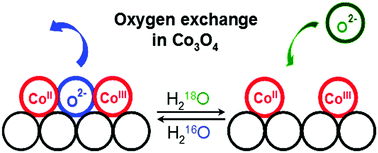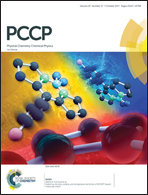How many surface atoms in Co3O4 take part in oxygen evolution? Isotope labeling together with differential electrochemical mass spectrometry†
Abstract
Understanding the mechanism underlying the oxygen evolution reaction (OER) on oxides is crucial for the development of many energy storage systems. Here, the mechanism of OER on a Co3O4 spinel catalyst is investigated in alkaline media using 18O-labeling combined with differential electrochemical mass spectrometry (DEMS). This work unravels the role of surface oxygen of the oxide in the OER. It is shown that in H218O-containing electrolyte the amount of 18O16O evolved increases from cycle to cycle together with a concomitant decrease of the amount of 16O2 with each cycle before reaching a steady-state value. 18O16O is also evolved from a H216O solution on a Co3O4 electrode pre-treated in H218O-containing solution, indicating the formation of the 18O-labeled oxide in the previous step. Therefore, the oxide layer takes part in OER via an oxygen exchange mechanism. The total number of oxygen atoms of the oxide participating in OER is 0.1 to 0.2% of the total oxide loading, corresponding to about 10–30% of the surface atoms; these represent the catalytically active sites. Moreover, the real surface area of the catalyst is estimated using different methods (namely the ball model, double layer capacitance method, redox peak method, isotope exchange), and compared to the BET data. The surface areas calculated from the BET data, ball model and redox peak method are similar for small particles, which indicates their smooth surface; however they are smaller than that estimated from double-layer capacitance. For larger particles, the much larger surface area estimated from the redox peak in comparison to that expected from the ball model seems to be due to their roughness. Thus, this work highlights the importance of probing the mechanism when investigating the OER activity of a catalyst.



 Please wait while we load your content...
Please wait while we load your content...